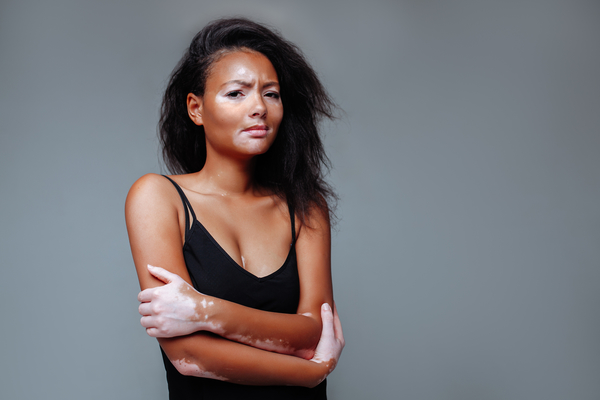Blog

Vitiligo related anxiety
Saturday 30th June 2018
Vitiligo, most commonly associated with the late musical artist Michael Jackson, is an autoimmune skin condition which results in white patches or spots on the skin.
Caused by a lack of melanin in the skin, it can appear across the body and face, and there is no real pattern as to when and where it will appear. There are several reasons cited as to why someone may get the condition – hereditary, stress, sunburn – however, ultimately the cause is unknown.
Just as the cause is unknown, there is no current real ‘vitiligo cure’. With one in one hundred people having vitiligo, many use skin camouflage make-up, try laser treatment and depigmentation treatments. While others simply refuse to hide and wear their patches with pride.
Sadly, most people with vitiligo suffer anxiety, embarrassment, helplessness and low self-esteem. The psychological impact of the condition can be debilitating and with Summer in full force, the thought of exposing these skin patches will be simply too much for some people.
Stuck in a stress-vitiligo cycle
Recent research by D Vernwal, of Government Medical College India, studied the correlation between anxiety and vitiligo using a mixed gender group of 100 vitiligo participants and 100 participants without the skin condition. It concluded that mixed anxiety and depression was significantly higher in those with vitiligo and that it particularly affected marital, sex life and intimacy. “This generates psychological distress and disrupts the social relationship and creates a vicious stress-vitiligo cycle,” the report cited.
This stress-vitiligo cycle is often self-perpetuating because the lack of control over the actual condition leaves the person feeling more vulnerable and, in their mind, unable to help themselves; while the social and relationship anxiety can result in people with vitiligo to be fearful to go out. Fearful to be caught out without their make-up. Fearful of ridicule. Just fearful.
Inspiring stories
However, society is becoming more welcoming and recent modelling campaigns have paved the way to a new understanding of vitiligo.
In 2017, Gap released a campaign – Fearless Beauty – for its collaboration with Disney, described as a celebration of “strength and bravery”.During the video campaign, a very confident eleven-year-old April talks about how many selfies she has taken and that “confidence is courage”.
Similarly, last August, model Winnie Harlowe who also has vitiligo, posed in just a nude thong and silver hoop earrings, showing the white vitiligo patches all over her body. Posted on her Instagram account, she said:“The real difference isn't my skin. It's the fact that I don't find my beauty in the opinions of others. I'm beautiful because I know it. Celebrate Your unique beauty today (& everyday)!”
Self-acceptance
This self-acceptance and confidence is inspiring and can also be accessible, with the correct treatment and help.
Self-acceptance is the beginning to challenging your beliefs and taking back your control and is the best vitiligo treatment available.
The BBC recently highlighted vitiligo in its series MisFITS Like Us and in an interview with Alec King, a young man with vitiligo, he is no longer desperately seeking a cure but is embracing the patches on his skin.
If you can change the way you think and behave and see your perceived challenges of vitiligo as an opportunity and a reason to find yourself and your strength, your acceptance of vitiligo as your strength and uniqueness is the first steps to creating that new confident you.
Techniques
There are various techniques that can be learnt in order to challenge your way of thinking, starting with an assessment of where the root of the anxiety towards your vitiligo stems. Is it from previous ridicule, a history of low self-esteem, or the shock of the sudden onset of the condition? All of these issues need to be explored to establish the correct therapy needed.
Some of the therapies that can be extremely helpful include the following.
CBT
Cognitive Behavioural Therapy(CBT) is based on the idea that negative feelings arise in the context of certain patterns of thinking and behaviours and change is needed to break these vicious cycles. Therefore, because CBT therapy directly addresses negative thinking and helps challenge and replace such thoughts with more balanced and positive logic, it can be extremely helpful when addressing vitiligo related anxiety.
ACT
Acceptance and Commitment Therapy(ACT) is a cutting-edge development withinCBT, which places greater emphasis on how to engage in helpful behaviours, spending less time and energy analysing and changing unhelpful thoughts. Depending on where the vitiligo related stress comes from, this type of therapy may be ideal.
Psychological Therapy & Counselling
Ongoing talking therapy and counselling focuses on exploring the past and understanding how it is linked to current struggles. Again, if there is a strong history of anxiety, this may be the therapy that can help overcome vitiligo related anxiety.
Psychodermatology Therapy
Research shows that psychological factors such as stress have an effect on many skin disorders and can actually exacerbate the problem, creating a vicious cycle of increased anxiety and patches. This type of therapy is specific to skin conditions and is ideal if there are no other anxiety related issues.
It is always recommended to seek professional help to establish the best course of treatment and be confident that you can beat vitiligo related anxiety and take back control of your life.
1 European Psychiatry Journal: https://www.sciencedirect.com/science/article/pii/S0924933817325130
2 MisFITS Like Us BBC 3: https://www.bbc.co.uk/bbcthree/article/a773ca84-76f0-4bc1-a6ab-987c9dbac4cd
